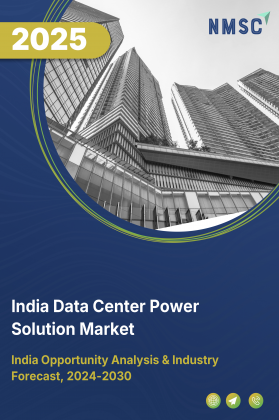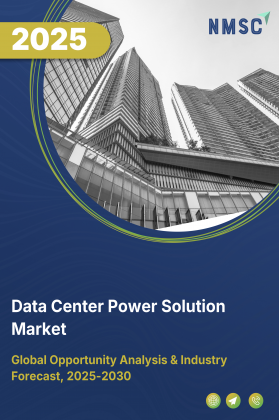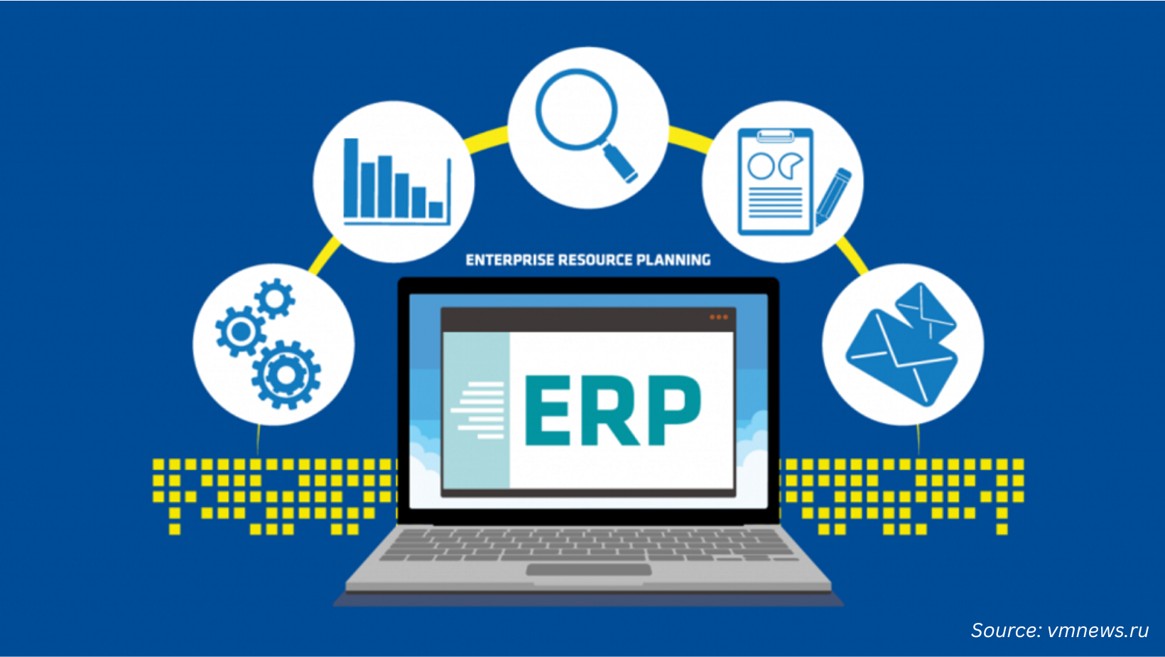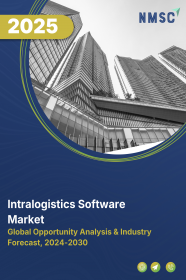
Intralogistics Software Market by Component (Software (Warehouse Management System, Transportation Management System, and Others), and Services), by Technology (Internet of Things, Artificial Intelligence, Big Data Analytics, Cloud Security, Digital Twins, and Others), by Deployment Mode (On-Premises and Cloud-Based), and by End-Users – Global Opportunity Analysis and Industry Forecast, 2025–2030
Industry: ICT & Media | Publish Date: 04-Sep-2025 | No of Pages: 476 | No. of Tables: 353 | No. of Figures: 278 | Format: PDF | Report Code : IC3360
Industry Overview
The global Intralogistics Software Market size was valued at USD 9.51 billion in 2024 and is expected to be valued at USD 11.30 billion by the end of 2025. The industry is projected to grow further, reaching USD 23.56 billion by 2030, with a CAGR of 15.8% between 2025 and 2030.
The rapid growth of e-commerce and the shift to omnichannel retailing are driving demand for intralogistics software, as businesses require efficient systems to manage complex order fulfillment and inventory workflows.
Adoption of Industry 4.0 technologies like AI, IoT, and cloud computing further accelerates market expansion by enabling real-time optimization and predictive analytics. In the automotive sector, especially with the rise of electric vehicles, manufacturers are increasingly relying on warehouse management software to streamline supply chains and improve operational efficiency.
However, high implementation and ownership costs remain a key barrier, particularly for small and mid-sized enterprises. Despite this challenge, the integration of emerging technologies such as generative AI and blockchain offers strong growth potential. These tools enhance demand forecasting, improve warehouse resource planning, and ensure secure, transparent supply chain tracking. As industries seek smarter, scalable solutions, the market is poised for continued innovation and growth.
Surge In E-commerce Industry Boosts The Growth Of The Intralogistics Market
The rapid expansion of e-commerce, driven by growing online consumer demand, is a key driver for the intralogistics market. It increases the need for efficient warehousing and streamlined order fulfilment systems. Intralogistics solutions such as automated storage and retrieval systems (ASRS), conveyor systems, and warehouse management software (WMS) enable rapid order processing, accurate inventory tracking, and optimized last-mile delivery. According to the U.S. International Trade Administration, global B2C e-commerce revenue is projected to increase from USD 4.6 trillion in 2023 to USD 7.9 trillion by 2028, reflecting a growth of approximately 71.74%. This substantial e-commerce growth accelerates the adoption of scalable, high-speed intralogistics systems, propelling market expansion by enhancing supply chain efficiency and meeting consumer expectations for faster deliveries.
Advancement In Robotic As/rs Technology Drives The Growth Of The Market
Innovations in robotic automated storage and retrieval systems (AS/RS) are driving the growth of the global intralogistics market. These advancements enhance warehouse efficiency, flexibility, and scalability to meet evolving demands. The launch of Exotec’s Next Generation Skypod system in February 2025 exemplifies this trend. It introduces a compact robot design, robot-to-robot picking workstations, high-throughput Exchangers, and denser storage capabilities. These improvements increase workstation throughput by 50% and storage density by up to 30% compared to the previous generation. These technological advancements meet the intralogistics market's demand for high-performance, adaptable solutions, especially in e-commerce, retail, and grocery sectors, where fast order processing and space optimization are essential. By enabling faster, more efficient, and cost-effective operations, advanced AS/RS technologies, like the Skypod system, drive significant market growth.
Rising Adoption Of Industrial Robotics Worldwide Boosts The Market Expansion
The widespread adoption of industrial robots is another key driver of the global intralogistics market. These systems enhance efficiency, precision, and scalability in warehouses, distribution centers, and manufacturing facilities. Industrial robots, including automated storage and retrieval systems (AS/RS), robotic arms, and mobile manipulators, optimize material handling, inventory management, and order fulfilment, addressing the demands of e-commerce, retail, and industrial sectors. According to the International Federation of Robotics (IFR) World Robotics 2024 report, the global operational stock of industrial robots reached 4,281,585 units in 2023, marking a 10% increase from the previous year. Annual installations in 2023 totaled 541,302 units, and the global average robot density surged to 162 units per 10,000 employees in 2023, more than double the 74 units per 10,000 employees recorded in 2016. This surge in industrial robot adoption, driven by labor shortages, rising costs, and the need for high-speed operations, fuels the intralogistics market by enabling faster, more cost-effective, and flexible warehouse processes. This is particularly evident in high-demand sectors such as e-commerce and automotive.
High Initial Investment And Ongoing Maintenance Costs Hindering Market Growth
A major challenge in the intralogistics market is the high initial investment and ongoing maintenance costs associated with advanced technologies like automated storage and retrieval systems (AS/RS) and robotic solutions. These systems often require substantial capital for installation and regular upkeep, which can be a barrier for small and medium-sized enterprises (SMEs) with limited budgets. Additionally, the complexity of integration and the need for specialized staff to manage and maintain these systems further increase operational costs, potentially limiting adoption in cost-sensitive industries.
Integration Of AI And Automation In Intralogistics Presents Significant Opportunities For Market Growth
The integration of generative AI (GenAI) and intelligent automation in intralogistics presents a significant opportunity for market growth because these technologies enhance operational efficiency, scalability, and cost-effectiveness. By automating tasks, optimizing workflows, and reducing manual intervention, businesses can achieve faster order processing, cost savings, and improved accuracy, all while adapting to changing demands. In 2025, KION Group introduced the use of GenAI to optimize warehouse processes, streamlining operations and reducing labor costs. Similarly, Siemens unveiled the Simatic Robot Pick AI Pro at LogiMAT 2025, an AI-powered system that allows robots to perform model-free 3D picking of diverse and unknown objects, significantly enhancing inventory handling efficiency. These developments showcase how AI and automation are driving substantial advancements in the intralogistics market, improving efficiency and positioning the industry for sustained growth.
By Component, Software Holds the Dominant Share in the Market
Software continues to lead the intralogistics market in terms of component share. This dominance is attributed to the increasing adoption of advanced solutions such as Warehouse Management Systems (WMS), Transportation Management Systems (TMS), and automated order fulfillment software. These tools enable real-time data tracking, process optimization, and enhanced inventory control, which are critical for modern warehouse and distribution operations. As industries focus on improving operational efficiency and reducing downtime, the demand for robust and scalable software solutions is expected to further drive growth in this segment.
By End-User, Semiconductor, Holds the Highest CAGR of 18.4%
The semiconductor segment leads with the highest CAGR of 18.4% in the global market share, driven by strong government investments in 2024 and 2025. Intel Corporation and the Biden-Harris Administration reported that the U.S. Department of Commerce and Intel have reached an agreement on terms to award the company up to $7.86 billion in direct funding for its commercial semiconductor manufacturing projects under the U.S. CHIPS and Science Act.
Thus, the infusion of capital is expected to accelerate production capacity expansion, necessitating advanced intralogistics software for streamlined material handling, inventory management, and real-time operational visibility. Consequently, this further stimulate growth within the semiconductor segment of the market.
North America Dominates Intralogistics Software Market Share
North America leads the global intralogistics software industry, driven by advanced technology, e-commerce growth, and widespread AI and automation adoption in warehouse operations. In 2024, U.S. e-commerce sales reached USD 1,192.6 billion, fueling demand for warehouse management systems (WMS) and warehouse execution systems (WES) to optimize fulfillment processes.
Moreover, technological advancements in automation and robotics are further transforming intralogistics operations and the market. According to the U.S. Census Bureau, the adoption of AI technologies by U.S. businesses was on the rise. Surveys indicated that AI usage was expected to increase from 5.4% in early 2024 to approximately 6.6% by fall 2024, with significant variation across sectors. The adoption of automated guided vehicles (AGVs), autonomous mobile robots (AMRs), and warehouse management software (WMS) enhances efficiency, reduces labour dependency, and minimizes errors, contributing to the overall intralogistics software market growth
According to Statistics Canada, retail e-commerce sales rose by 3.4% to USD 4.1 billion in July 2024, making up 6.1% of total retail trade. This consistent rise in online shopping is compelling logistics providers to invest in scalable software platforms that support real-time inventory management, order tracking, and predictive analytics.
Furthermore, the AI implementation is gaining traction across North American businesses, and the growing reliance on digital commerce and automation across the U.S. and Canada is reshaping the regional intralogistics landscape, positioning North America as a hub for innovation and growth in the global sector.
Asia-Pacific Region Witnesses Fastest Growth in the Market with a CAGR of 18.0%
Technological advancements in automation and robotics are fundamentally reshaping intralogistics operations across the Asia-Pacific region. According to the 2024 report by The State Council of China, the country’s automobile production reached approximately 21.47 million units, reflecting a 1.9% year-on-year increase, while auto sales rose by 2.4% to 21.57 million units.
This growth has been accompanied by rising investments in automation within the automotive sector, particularly in assembly processes. The deployment of AGVs and AMRs and WMS is significantly improving operational efficiency, reducing reliance on manual labour, and minimizing errors, thereby accelerating the growth of the market.
In addition to industrial automation, the rapid expansion of e-commerce is serving as a major catalyst for intralogistics innovation. As highlighted in the Ministry of Commerce and Industry’s Annual Report 2023–24, India is actively enhancing its digital infrastructure and aims to boost e-commerce exports to between USD 200 billion and USD 300 billion by 2030. This digital transformation is expected to further drive demand for intelligent warehousing and logistics solutions across the region.
Strategic Advancements in the Intralogistics Software Industry by Key Players
The intralogistics software industry in 2024 is undergoing a strategic transformation, driven by rapid advancements in AI, robotics, and cloud-based technologies. Key industry players are leveraging these innovations to enhance warehouse automation, operational efficiency, and real-time decision-making.
Jungheinrich AG, for instance, has upgraded its Logistics Interface with AI-driven analytics to support predictive maintenance and system interoperability. DEMATIC has strengthened its iQ platform through integration with Google Cloud, enabling scalable, cloud-native warehouse execution solutions. Swisslog, under Midea Group, introduced generative AI into its SynQ software to create a “learning warehouse” capable of dynamic synchronization and process optimization.
Similarly, KUKA AG is advancing robotic software integration to streamline material handling through seamless system connectivity, while Knapp has launched its AI-enabled Pick-it-Easy Robot to improve picking accuracy and reduce human error. These strategic moves reflect a broader industry shift toward intelligent, data-driven intralogistics systems that can adapt to increasing order complexity and supply chain volatility.
However, challenges such as high implementation costs and cybersecurity risks persist, particularly in emerging economies. Despite this, the aggressive push toward AI integration, real-time analytics, and robotics is solidifying the leadership positions of these firms and accelerating global adoption of advanced intralogistics software solutions.
Intralogistics Software Market Key Segments
By Component
-
Software
-
Warehouse Management System (WMS)
-
Transportation Management System (TMS)
-
Yard Management Software
-
Inventory Management Software
-
Labor Management Software
-
Others
-
-
Services
By Technology
-
Internet Of Things (IoT)
-
Artificial Intelligence (AI)
-
Big Data Analytics
-
Cloud Security
-
Digital Twins
-
Others
By Deployment Mode
-
On-Premises
-
Cloud-Based
-
Hybrid
By End-User
-
Retail and E-commerce
-
Automotive
-
Food and Beverage
-
Pharmaceuticals
-
Aviation
-
Logistics
-
Semiconductor & Electronics
-
Consumer Goods
-
Others
By Region
-
North America
-
The U.S.
-
Canada
-
Mexico
-
-
Europe
-
The UK
-
Germany
-
France
-
Italy
-
Spain
-
Denmark
-
Netherlands
-
Finland
-
Sweden
-
Norway
-
Russia
-
Rest of Europe
-
-
Asia-Pacific
-
China
-
Japan
-
India
-
South Korea
-
Australia
-
Indonesia
-
Singapore
-
Taiwan
-
Thailand
-
Rest of Asia-Pacific
-
-
RoW
-
Latin America
-
Middle East
-
Africa
-
Key Players
-
Jungheinrich AG
-
Dematic Corp
-
Midea Group Co., Ltd.
-
Honeywell International Inc.
-
Daifuku Co., Ltd.
-
SSI SCHÄFER
-
Vanderlande Industries B.V.
-
KNAPP AG
-
TGW Logistics Group GmbH
-
AutoStore AS
Other Notable Players
-
Kardex AG
-
BEUMER Group
-
Bastian Solutions, LLC
-
Mecalux, S.A.
-
KUKA AG
-
SAP SE
-
Körber AG
-
Murata Machinery, Ltd.
-
FORTNA Inc.
-
System Logistics S.p.A.a
REPORT SCOPE AND SEGMENTATION:
|
Parameters |
Details |
|
Market Size in 2025 |
USD 11.30 Billion |
|
Revenue Forecast in 2030 |
USD 23.56 Billion |
|
Growth Rate |
CAGR of 15.8% from 2025 to 2030 |
|
Analysis Period |
2024–2030 |
|
Base Year Considered |
2024 |
|
Forecast Period |
2025–2030 |
|
Market Size Estimation |
Billion (USD) |
|
Growth Factors |
|
|
Companies Profiled |
20 |
|
Market Share |
Available for 10 companies |
|
Customization Scope |
Free customization (equivalent up to 80 working hours of analysts) after purchase. Addition or alteration to country, regional, and segment scope. |
|
Pricing and Purchase Options |
Avail customized purchase options to meet your exact research needs. |

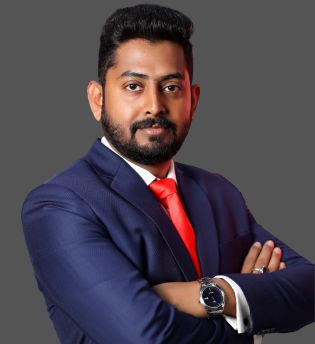















 Speak to Our Analyst
Speak to Our Analyst



